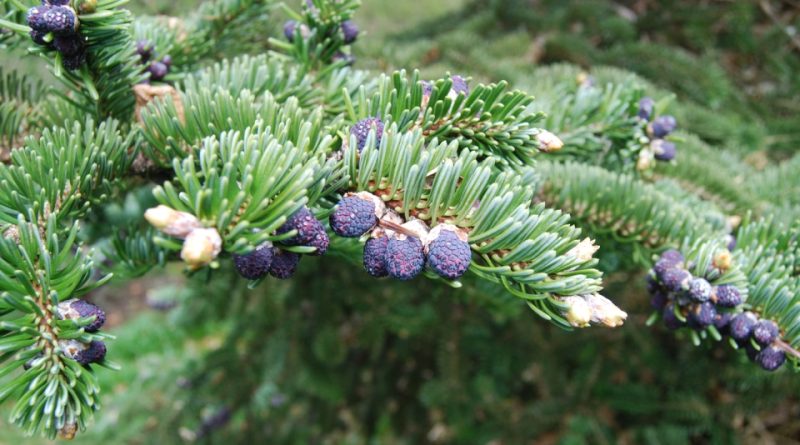Abies squamata
Abies squamata
The Flaky fir (Abies squamata Mast., 1906) is an arboreal species belonging to the Pinaceae family.
Systematics –
From a systematic point of view it belongs to:
Eukaryota Domain,
Kingdom Plantae,
Pinophyta Division,
Pinopsida class,
Order Pinales,
Pinaceae family,
Genus Abies,
A. squamata species.
Etymology –
The term Abies comes from Abies which is the classical Latin name (Virgil, Egloghe, from the Sanskrit root abh gush of resin); according to another interpretation it would derive from the Greek word ἄβιος = long-lived.
The specific scaly epithet refers to the wrinkled and plaque bark.
Geographic Distribution and Habitat –
Abies squamata is an endemic conifer of China (Xizang, Sichuan and Qinghai).
Its habitat is that of the high mountains, where it grows at altitudes between 3500 and 4500 meters, being among the tree species that reach the highest altitudes in the world; prefers podzol or mountain lithosols. The reference climate is cold and relatively dry, although permanent snows normally provide the necessary humidity throughout the year. It grows mainly in mixed forests with other conifers such as Abies recurvata, Abies fargesii, Picea likiangensis, Picea asperata, Picea linzhiensis, Larix potaninii and Tsuga forrestei. Few deciduous trees at these altitudes (Betula albosinensis and Betula utilis).
Description –
Abies squamata is an evergreen conifer that can reach 40 meters in height.
The trunk has a diameter of up to 2 m and the crown is conical. The branches of the first order develop horizontally, the lower ones are hanging and those of the second order are ascending. The shoots are dark reddish or purplish brown, mostly smooth.
The bark of the stem, smooth when young and purple, peels off as in the species of the genus Betula; in older trees it splits into brown-orange plaques.
The leaves are 1,5-2,5 cm long needles, silvery green above, and with two broad silver-white bands of stomata below, with acute or obtuse tips; they are arranged in a spiral, rigid, arranged in two comb series. The buds are rounded and ovoid, covered with white resin.
Male strobili are hanging, yellowish and 2-3 cm long, with purple microsporophylls.
The cones are erect, cylindrical-ovoid in shape, with short peduncle, 5-7 cm long and about 3-4 cm broad, blue-violet when young, brown-violet when mature; the flabellate-cuneate flakes are 1.5 cm wide, smooth and puberty. The bracts, oblong-spatulate, are 1,5-1,8 cm long.
Cultivation –
Abies squamata is a common conifer in the south-east of the Tibetan plateau (China) at an altitude of 3500 m up to the treeline at 4500 m. It dominates on north facing slopes and often grows with the Balfour spruce, Picea balfouriana.
This plant underwent sustained logging which significantly reduced these plants until the 1998 ban. Reforestation after the ban was dominated by spruce, as Abies squamata is susceptible to stem rot and therefore avoided by forestry offices state. The undergrowth is most commonly dominated by members of the Rhododendron genus.
Its reproduction takes place, as for other conifers, by seed.
The implantation of young seedlings must be carried out before they have formed an extended root system and therefore they should be transplanted in the open field when they have not reached a maximum height of 60 cm.
Customs and Traditions –
Local Tibetans know Abies squamata as “stamp”, but it is a generic term for other firs and spruces.
The exploitation of this species, in the last 150 years, has caused a reduction of the population of about 30%; for this reason it is classified as a vulnerable species in the IUCN Red List.
Today the high altitude area does not allow the economic exploitation of its wood. Its cultivation is rare as an ornamental plant, remaining confined to a few botanical gardens.
Preparation Method –
Abies squamata is a plant used, especially in the past, for its timber.
Today, after the ban on exploitation, it is considered a vulnerable species; furthermore, no food or medicinal uses are known.
Guido Bissanti
Sources
– Acta Plantarum – Flora of the Italian Regions.
– Wikipedia, the free encyclopedia.
– GBIF, the Global Biodiversity Information Facility.
– Useful Tropical Plants Database.
– Conti F., Abbate G., Alessandrini A., Blasi C. (ed.), 2005. An annotated checklist of the Italian vascular flora, Palombi Editore.
– Pignatti S., 1982. Flora of Italy, Edagricole, Bologna.
– Treben M., 2000. Health from the Lord’s Pharmacy, Advice and experiences with medicinal herbs, Ennsthaler Editore.
Photo source:
– https://repo.rbge.org.uk/image_server.php?kind=1500&path_base64=L2l0ZW1faW1hZ2VzL2FjY2Vzc2lvbnMvMTkvNzkvNTEvMzYvUGhvdG9fNTE5MjA5NjI5YjI0ZC5qcGc=
– http://cdn.flmnh.ufl.edu/Herbarium/jpg/270/270881a1.jpg
Warning: Pharmaceutical applications and alimurgical uses are indicated for informational purposes only, they do not represent in any way a medical prescription; therefore no responsibility is taken for their use for curative, aesthetic or food purposes.


